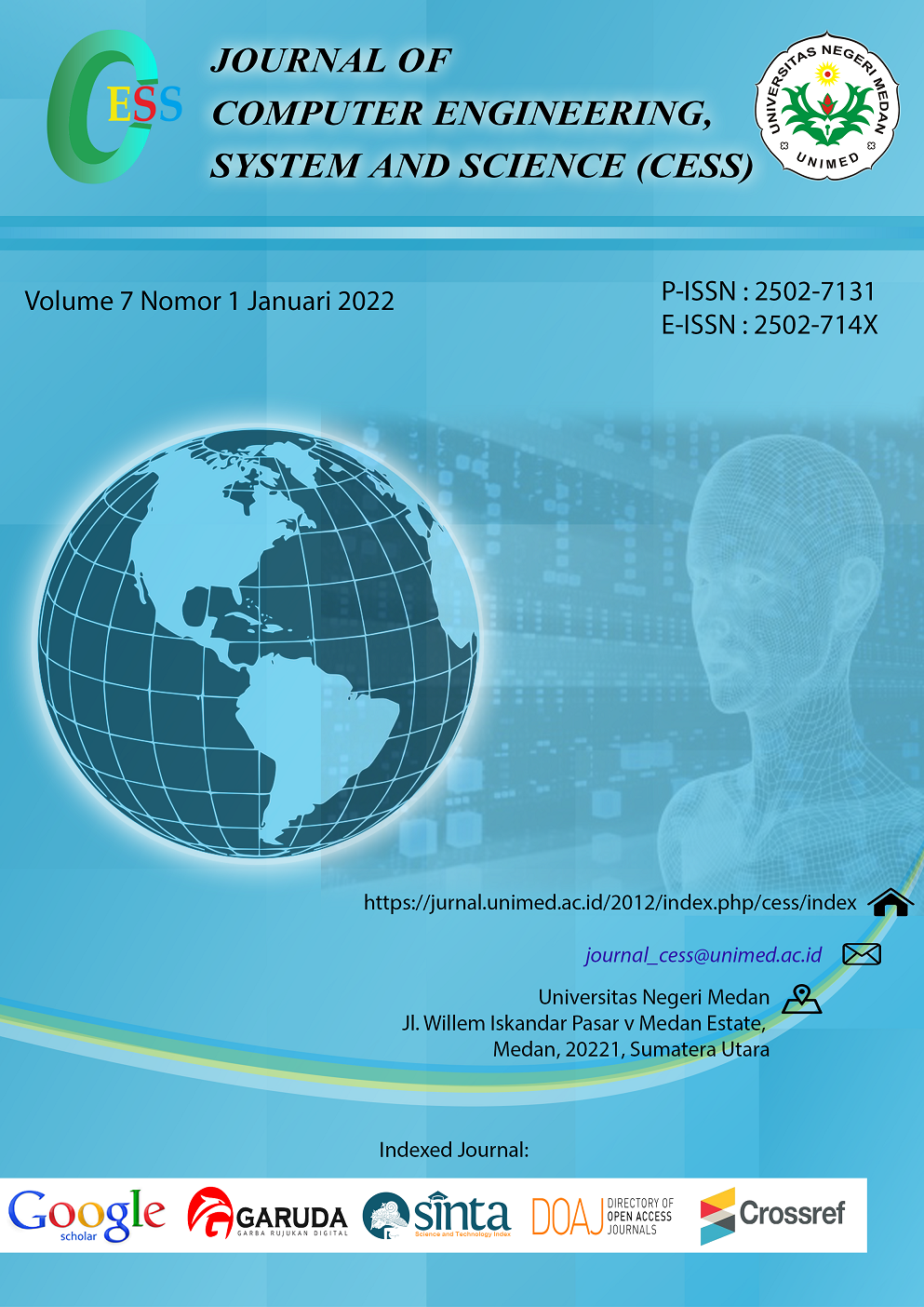5G Channel Model Under the Effect of Human Blockage at 3.5 GHz Frequency
DOI:
https://doi.org/10.24114/cess.v7i1.27291Keywords:
5G, Power Delay Profile, human blockage, non human blockage, Outage Probability, Frame Error Rate, Bit Error RateAbstract
Komunikasi seluler generasi kelima (5G) New Radio (NR) dengan kecepatan transfer data hingga 20 Gbps yang menggunakan frekuensi tinggi yaitu 6 GHz - 100 GHz. Menggunakan frekuensi yang tinggi maka kanal akan sensitif terhadap keadaan alam, dan human blockage. Penelitian ini menganalisis perbandingan kinerja model kanal 5G dengan dan tanpa pengaruh human blockage. Frekuensi yang digunakan sebesar 3,5 GHz dengan bandwidth 99 MHz menggunakan Cyclic Prefix-Orthogonal Frequency Division Multiplexing (OFDM) pada modulasi Quadrature Phase Sshift Keying (QPSK). Penelitian model kanal 5G yang direpresentasikan dalam Power Delay Profile (PDP) representative didapatkan sebanyak 37 path dengan dan tanpa pengaruh human blockage. Hasil dari penelitian menunjukkan untuk mendapatkan outage performances sebesar 10-3, membutuhkan Signal to Noise Ratio (SNR) sebesar 22 dB dengan pengaruh human blockage dan SNR sebesar 22,3 dB pada tanpa pengaruh human blockage (non human blockage). Kinerja Frame Error Rate (FER) pada 10-3 membutuhkan SNR sebesar 46,5 dB dengan pengaruh human blockage dan SNR sebesar 46,8 dB untuk non human blockage. Kinerja Bit Error Rate (BER) untuk mencapai 10-4 membutuhkan SNR sebesar 35dB dengan pengaruh human blockage dan SNR sebesar 35,5 dB non human blockage. Hasil menunjukkan bahwa human blockage pada frekuensi 3,5 GHz dapat mempengaruhi kinerja sistem 5G dan membutuhkan strong codes untuk meminimalkan error seperti convolutional, polar, dan repetition codes.Downloads
References
K. Haneda et al., œ5G 3GPP-like channel models for outdoor urban microcellular and macrocellular environments, IEEE Veh. Technol. Conf., vol. 2016-July, 2016, doi: 10.1109/VTCSpring.2016.7503971.
ITU-R, œIMT Vision “ Framework and overall objectives of the future development of IMT for 2020 and beyond, Itu-R M.2083-0, vol. 0, p. https://www.itu.int/dms_pubrec/itu-r/rec/m/R-REC-M, 2015.
T. A. Nugraha and A. Hikmaturokhman, œSimulasi Penggunaan Frekuensi Milimeter Wave Untuk Akses Komunikasi Jaringan 5G Indoor, J. Infotel, vol. 9, no. 1, pp. 24“30, 2017, doi: 10.20895/infotel.v9i1.144.
E. M. Alfaroby, N. M. Adriansyah, and K. Anwar, œStudy on channel model for Indonesia 5G networks, 2018 Int. Conf. Signals Syst. ICSigSys 2018 - Proc., pp. 125“130, 2018, doi: 10.1109/ICSIGSYS.2018.8372650.
S. Ju, O. Kanhere, Y. Xing, and T. S. Rappaport, œA millimeter-wave channel simulator NYUSIM with spatial consistency and human blockage, 2019 IEEE Glob. Commun. Conf. GLOBECOM 2019 - Proc., pp. 1“6, 2019, doi: 10.1109/GLOBECOM38437.2019.9013273.
C. King, œFundamentals of wireless communications, 2014 67th Annu. Conf. Prot. Relay Eng. CPRE 2014, pp. 470“474, 2014, doi: 10.1109/CPRE.2014.6799022.
C. E. Shannon, œA Mathematical Theory of Communication, Bell Syst. Tech. J., vol. 47, no. 6, pp. 957“1000, 1968, doi: 10.1002/j.1538-7305.1968.tb00069.x.
K. Anwar, E. Christy, and R. P. Astuti, œIndonesia 5G Channel Model Under Foliage Effect [Model Kanal 5G Indonesia dengan Pengaruh Dedaunan], Bul. Pos dan Telekomun., vol. 17, no. 2, p. 75, 2019, doi: 10.17933/bpostel.2019.170201.
I. Purnomo, A. A. Muayyadi, and D. M. Saputri, œNumerology Effect on 5G 28 GHz Communication System Performance, Proc. - 2020 Int. Semin. Intell. Technol. Its Appl. Humanification Reliab. Intell. Syst. ISITIA 2020, pp. 332“337, 2020, doi: 10.1109/ISITIA49792.2020.9163767.
M. L. Hakim, Sukiswo, and Imam Santoso, œAnalisis Kinerja Sistem MIMO-OFDM pada Kanal Rayleigh dan AWGN dengan Modulasi QPSK, Transmisi, vol. 12, no. 4, pp. 150“154, 2010, doi: 10.12777/transmisi.12.4.150-154.
P. Guan et al., œ5G field trials: OFDM-based waveforms and mixed numerologies, IEEE J. Sel. Areas Commun., vol. 35, no. 6, pp. 1234“1243, 2017, doi: 10.1109/JSAC.2017.2687718.
E. Christy, R. P. Astuti, and K. Anwar, œTelkom University 5G Channel Models under Foliage Effect and Their Performance Evaluations, Proceeding - 2018 Int. Conf. ICT Rural Dev. Rural Dev. through ICT Concept, Des. Implic. IC-ICTRuDEv 2018, no. 1, pp. 29“34, 2018, doi: 10.1109/ICICTR.2018.8706848.
Downloads
Published
How to Cite
Issue
Section
License
Copyright (c) 2021 CESS (Journal of Computer Engineering, System and Science)

This work is licensed under a Creative Commons Attribution 4.0 International License.















